F1.1 Identify different ways of representing the same amount of money up to Canadian 200¢ using various combinations of coins, and up to $200 using various combinations of $1 and $2 coins and $5, $10, $20, $50, and $100 bills.
Skill: Identifying Different Ways of Representing the Same Amount of Money
Using the concepts of composition and decomposition of whole numbers from the Number strand, students use money to find many ways to arrive at the same value (quantity) using concrete or visual proportional representations of coins and bills.
Money is a concrete representation of unitized sums of numbers. Students can practice representing quantity by first using concrete, visual, and proportional representations of coins and bills (interlocking cubes and the hundreds chart model) as well as writing down sums of money and matching them to their concrete or visual representation.
A sum of money can be represented in a variety of ways, such as using manipulatives, a structured list, or drawings.
In order to obtain a desired amount of money by combining coins and bills, it is necessary to understand the value of each bill or coin and its value. Creating and analyzing sequences or patterns, as the value of coins or bills is broken down, allows the student to understand the relationships between different representations of the same amount of money.
Students learn more about the value of money and bills by skip counting and by composing and decomposing numbers.
Example 1
To represent 75¢, several combinations of coins can be used.
Here are five possible combinations using the cubes model to represent the sum of 75¢ in concrete terms.
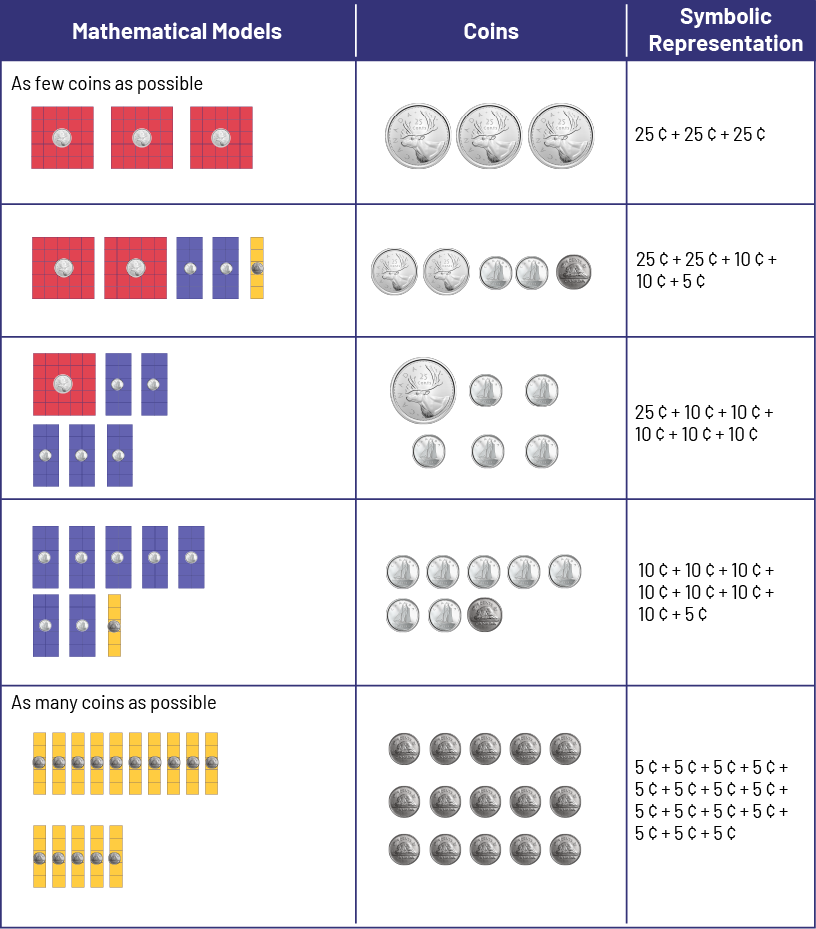
Representation using a model: 3 blocks of 25 red squares, Coins: 3 quarters, Symbolic representation: 25 cents, plus 25 cents, plus 25 cents. Representation using a model: 2 blocks of 25 red squares, 2 blocks of ten blue squares, a block of 5 yellow squares, a dime, plus, Coins: 2 quarters, 2 dimes, one nickel. Symbolic representation: 25 cents, plus 25 cents, plus ten cents, plus ten cents, plus 5 cents. Representation using a model: a block of 25 red squares, 5 blocks of ten blue squares. Coins: one quarter, 5 dimes. Symbolic representation: 25 cents, plus, ten cents, plus ten cents, plus ten cents, plus ten cents, plus ten cents. Representation using a model: 7 blocks of ten blue squares, one block of 5 yellow squares. Coins: 7 dimes, one nickel. Symbolic representation: ten cents, plus, ten cents, plus, ten cents, plus, ten cents, plus, ten cents, plus, ten cents, plus, ten cents, plus, 5 cents. Representation using a model: 15 blocks of 5 yellow squares. Coins: 15 nickels. Symbolic representation: 5 cents plus 5 cents, repeated 7 times, plus 5 cents.
Example 2
Students can also use patterns to determine different ways to arrive at the sum of 75¢.
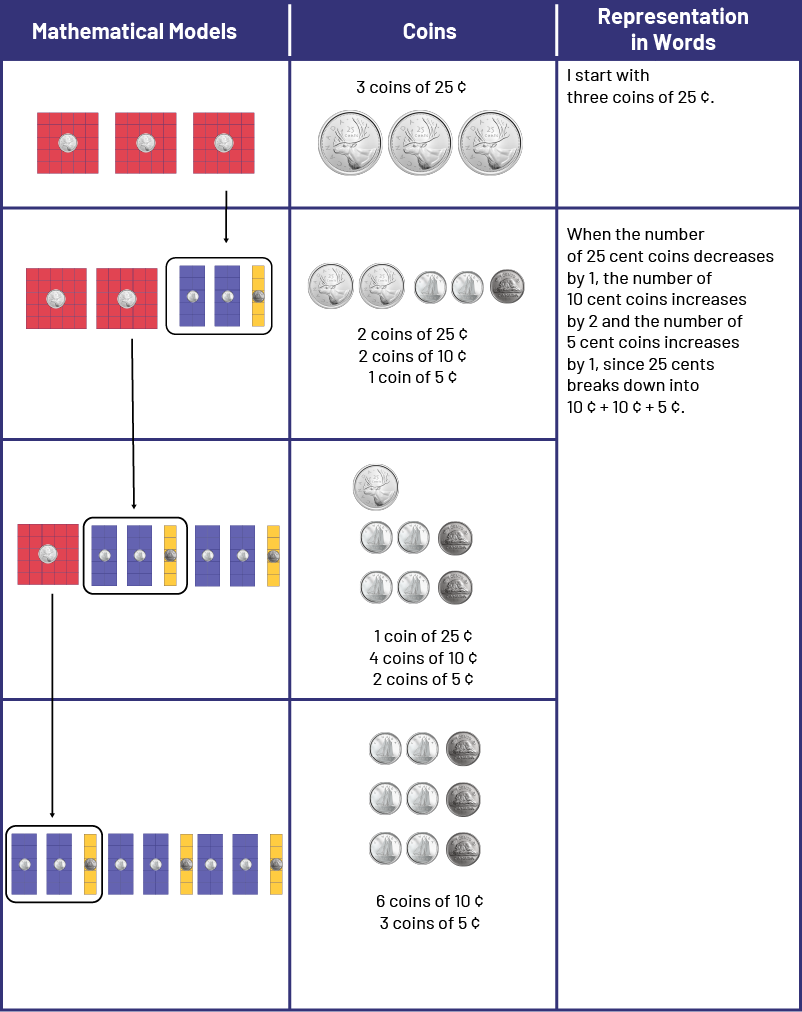
Representation using a model: 3 blocks of 25 red squares, Coins: 3 quarters Representation in words: I start with 3 quarters. Representation using a model: 2 blocks of 25 red squares, 2 blocks of ten blue squares, one block of 5 yellow squares. Coins: 2 quarters, 2 dimes, one nickel. Representation in words: When the number of quarters decreases by one, the number of dimes increases by 2 and the number of nickels increases by one, since 25 cents breaks down into ten cents, plus ten cents, plus 5 cents. Representation using a model: a block of 25 red squares, 4 blocks of ten blue squares, 2 blocks of 5 yellow squares. Coins: one quarter, 4 dimes, 2 nickels. Representation in words: When the number of quarters decreases by one, the number of dimes increases by 2 and the number of nickels increases by one, since 25 cents breaks down into ten cents, plus ten cents, plus 5 cents. Representation using a model: 6 blocks of ten blue squares, 3 blocks of 5 yellow squares. Coins: 6 dimes, 5 nickels. Representation in words: When the number of quarters decreases by one, the number of dimes increases by 2 and the number of nickels increases by one, since 25 cents breaks down into ten cents, plus ten cents, plus 5 cents. Arrows point us that a block of 25 red squares represent the same value as 2 blocks of ten blue squares and a block of 5 yellow squares.
Students learn that there are many ways to represent the same amount of money using different bills and coins of at least one dollar.
Example 1
Here are five different combinations of bills and coins of at least one dollar to represent $30.
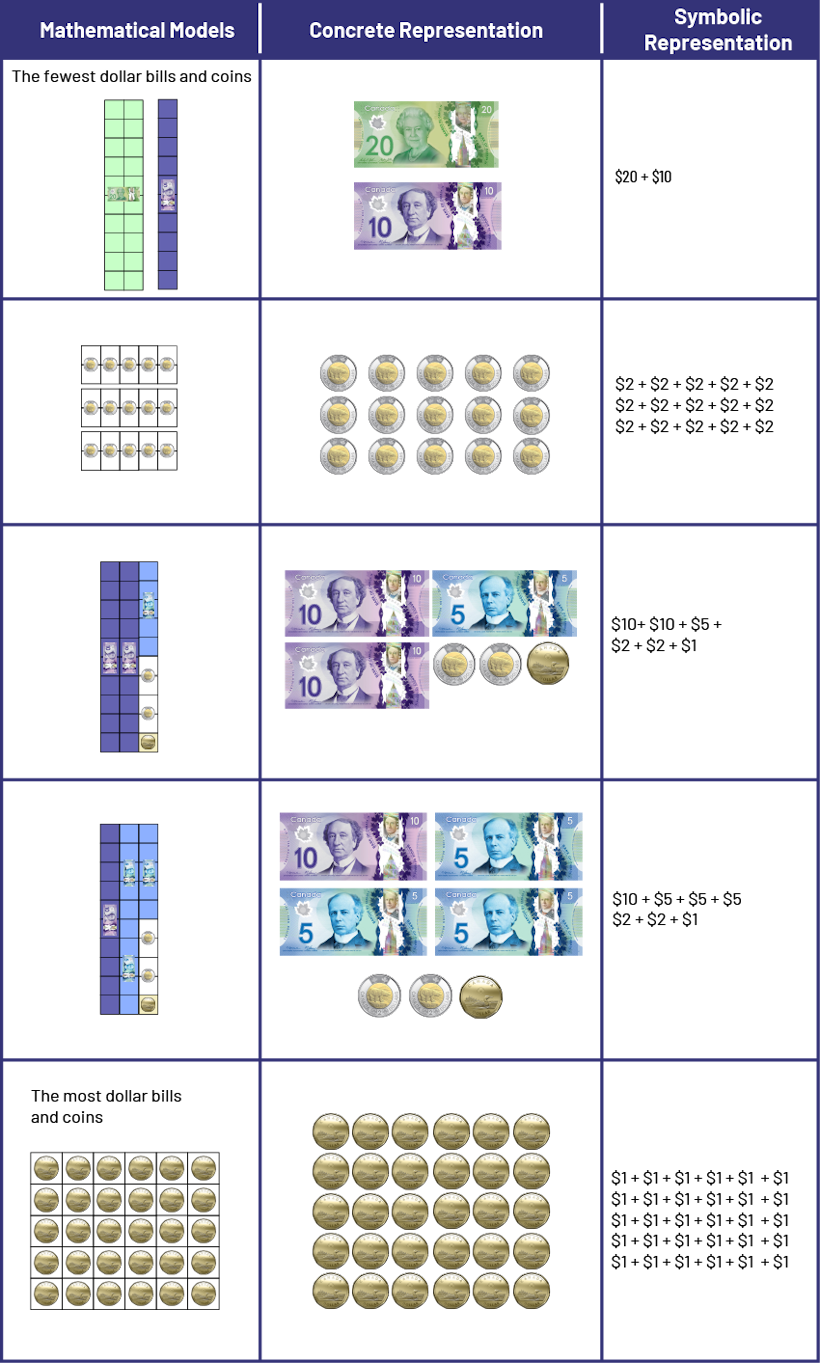
Representation using models: a block of 20 green squares, and a block of ten purple squares. Coins and bills: a 20-dollar bill and a ten-dollar bill. Symbolic representation: 20 dollars plus ten dollars. Representation using models: 2 squares representing 2 dollars, repeated 15 times. Coins and Notes: 15 coins of 2 dollars each. Symbolic representation: 2 dollars plus 2 dollars, repeated 7 times, plus 2 dollars. Representation using models: 2 blocks of ten purple squares, one block of 5 blue squares, two white squares and one yellow square. Coins and notes: 2 ten-dollar bills, a 5-dollar bill, 2 two-dollar coins and one one-dollar coin. Symbolic representation: ten dollars, plus, ten dollars, plus 5 dollars, plus 2 dollars, plus 2 dollars, plus one dollar. Representation using models: a block of ten purple squares, 3 blocks of 5 blue squares, a block of 2 white squares, a yellow square. Coins and bills: one ten-dollar bill, 5 five-dollar bills, 2 two-dollar coins, one one-dollar coin. Symbolic representation: ten dollars, plus, 5 dollars, plus 5 dollars, plus, 5 dollars, plus 2 dollars, plus 2 dollars, plus a dollar. Representation using models: 30 yellow squares, Coins and notes: 30 one-dollar coins. Symbolic representation: one dollar plus one dollar, repeated 15 times.
Example 2
Students can also use a pattern to determine different ways to arrive at $30.
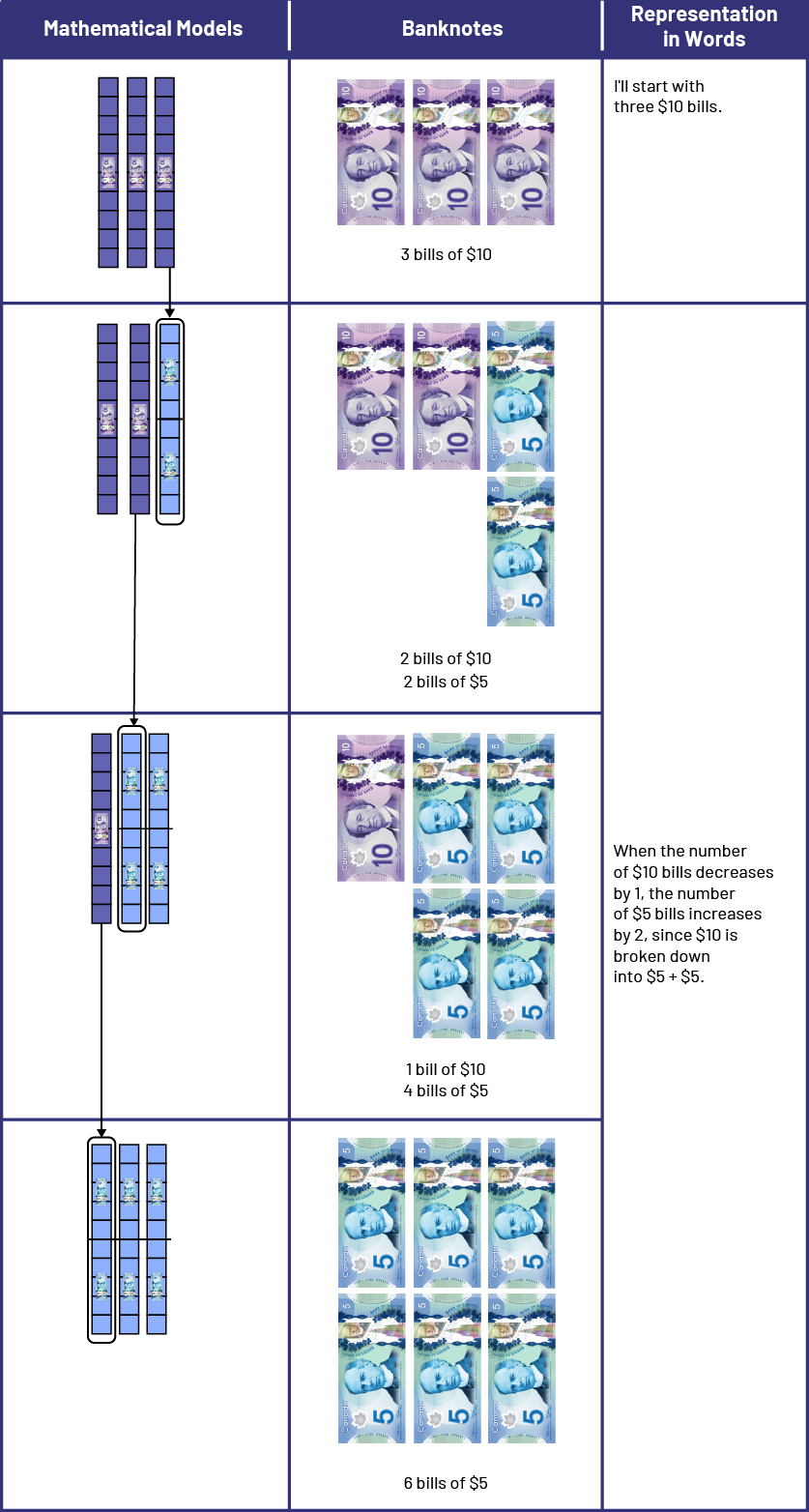
Representation using models: 3 blocks of ten purple squares. Bills: 3 ten-dollar bills. Representation in words: I start with 3 ten dollar bills. Representation using models: 2 blocks of ten purple squares, 2 blocks of 5 blue squares. Bills: 2 ten-dollar bills, 2 5-dollar bills. Representation in words: When the number of ten dollar bills decreases by one, the number of 5 dollar bills increases by 2, since ten dollars is broken down into 5 dollars plus 5 dollars. Representation using models: a block of ten purple squares, 4 blocks of 5 blue squares. Bills: one ten-dollar bill, 4 five-dollar bills. Representation in words: When the number of ten dollar bills decreases by one, the number of 5 dollar bills increases by 2, since ten dollars is broken down into 5 dollars plus 5 dollars. Representation using models: 6 blocks of 5 blue squares. Bills: 6 x 5 dollar bills. Representation in words: When the number of ten dollar bills decreases by one, the number of 5 dollar bills increases by 2, since ten dollars is broken down into 5 dollars plus 5 dollars. Arrows underline the equivalences: A block of ten purple squares is equivalent to 2 blocks of 5 blue squares. A ten-note bill is equal to 2 five-dollar bills.
Example 3
The cost of four items is $127. Show different ways to pay for these items using various strategies.
Strategy 1
I use the hundreds grid model to represent $127.

Here is my equation:
100 + 20 + 5 + 2 = 127
Strategy 2
I use the number line to represent bills and coins of at least one dollar to arrive at $127.

127 dollars. Numerical sentence: 120 dollars, plus 6 dollars, plus one dollar. A number line that starts at zero and continues up to 150 dollars. Plus ten jumps start at zero and repeat up to 120 dollars, then plus 2 jumps repeated 3 times, and plus one jump.
I make twelve hops of 10, three hops of 2 and one hop of 1.
Then I take the bills and coins according to what is represented on the number line. I can pay for the items with 12 $10 bills, 3 $2 coins and 1 $1 coin.
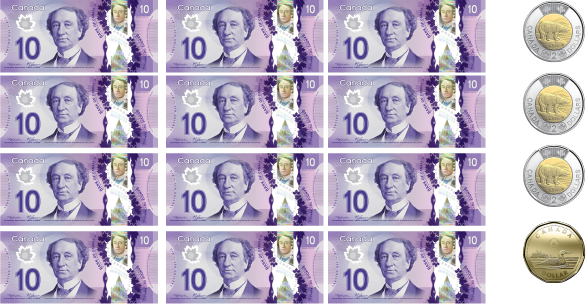
Strategy 3
I use play money to represent the amount, and use skip counting. I use 2 $50 bills, 1 $20 bill, 1 $5 bill, and 1 $2 coin. My count then
becomes 50, 100, 120, 125, 127.

Knowledge: Value of Coins and Bills (5¢ to $100) Using Proportional Models
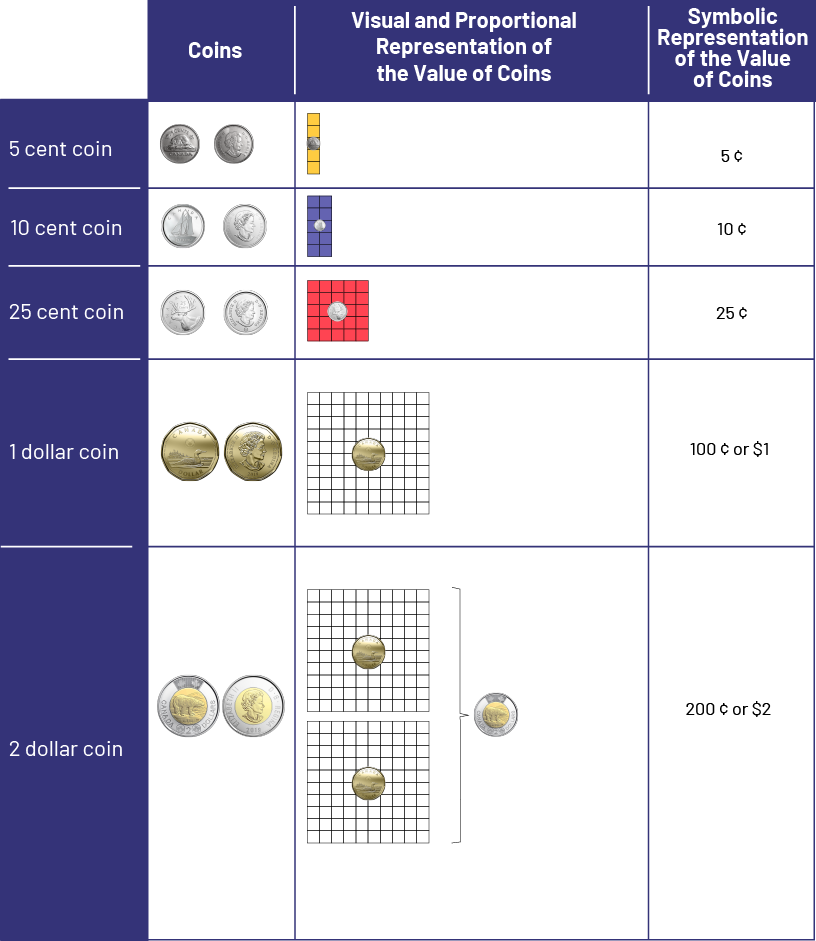
Coin: 5 cents front and back. Visual and proportional representation of the value of coins: a block of 5 yellow squares. Symbolic representation of the value of coins: 5 cents. Coin: ten cents front and back Visual and proportional representation of the value of coins: a block of ten blue squares. Symbolic representation of the value of coins: ten cents. Coin of: 25 cents, front and back. Visual and proportional representation of the value of the coins: a block of 25 red squares. Symbolic representation of coin value: 25 cents Coin: one dollar, front and back. Visual and proportional representation of the value of the coins: a block of 100 white squares. Symbolic representation of the value of coins: 100 cents or a dollar. Coin: 2-dollar coin, front and back. Visual and proportional representation of the value of the coins: 2 blocks of 100 white squares. Symbolic representation of coin value: 200 cents or 2 dollars.
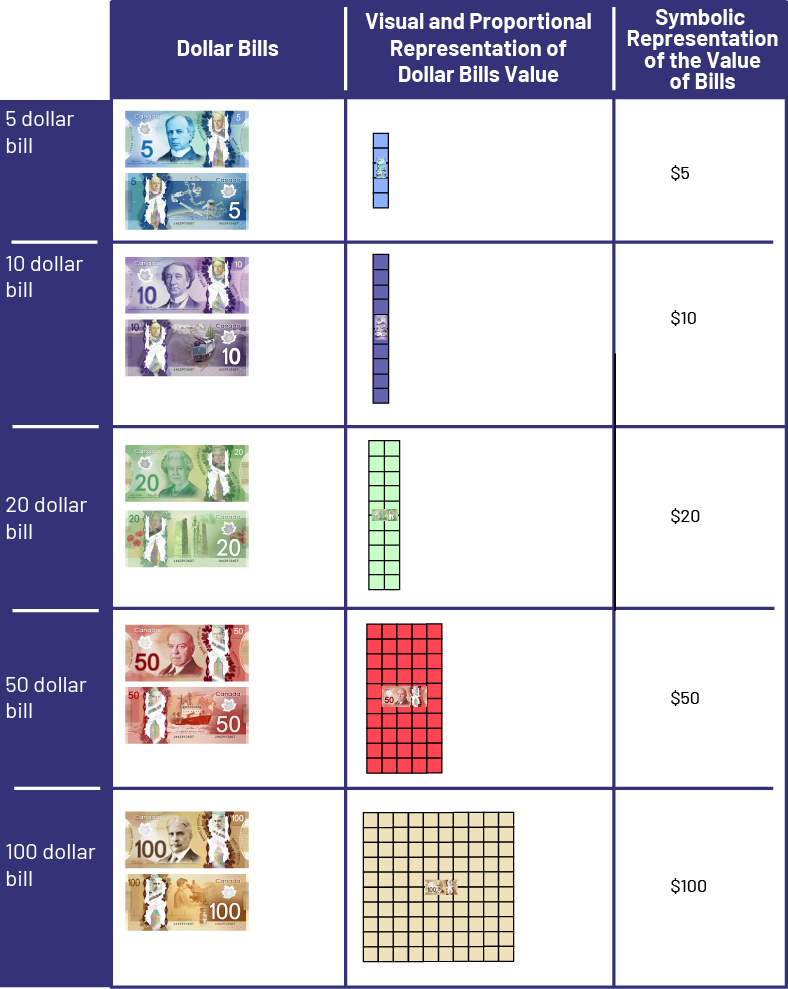
Money bill: 5 dollars, front and back. Visual and proportional representation of the value of bills: a block of 5 blue squares. Symbolic representation of the value of the bills: 5 dollars. Money bill: ten dollars, front and back. Visual and proportional representation of the value of bills: a block of ten purple squares. Symbolic representation of the value of bills: ten dollars. Money bill: 20 dollars, front and back. Visual and proportional representation of the value of bills: a block of 20 green squares. Symbolic representation of the value of the bills: 20. dollars Money bill: 20 dollars, front, back. Visual and proportional representation of the value of bills: a block of 50 red squares. Symbolic representation of the value of the bills: 50 dollars. Money bill: 100 dollars, front and back. Visual and proportional representation of the value of bills: a block of 100 brown squares. Symbolic representation of the value of the bills: 100 dollars.
